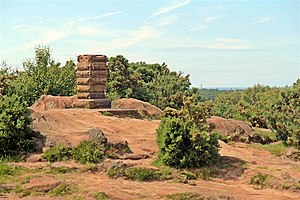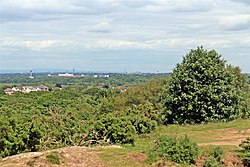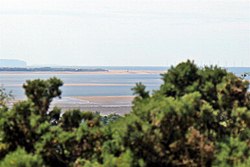Thurstaston Common: Difference between revisions
Created page with "250px|right|thumb|300px|Signpost on Thurstaston Common {{county|Cheshire}} *Location map: {{wmap|53.355|-3.1..." |
No edit summary |
||
| Line 1: | Line 1: | ||
[[File:Direction Marker, Thurstaston Hill (geograph 2990383).jpg|250px|right|thumb|300px|Signpost on Thurstaston Common]] | [[File:Direction Marker, Thurstaston Hill (geograph 2990383).jpg|250px|right|thumb|300px|Signpost on Thurstaston Common]] | ||
{{county|Cheshire}} | {{county|Cheshire}} | ||
'''Thurstaston Common''' is an area of common land with almost 250 acres of parklands, wood and heath between [[Frankby]] and [[Thurstaston]], on the [[Wirral]] Peninsula of [[Cheshire]]. The common is jointly owned by [[National Trust for Places of Historic Interest or Natural Beauty|National Trust]] and the local council. Royden Country Park is nearby and offers additional facilities. | '''Thurstaston Common''' is an area of common land with almost 250 acres of parklands, wood and heath between [[Frankby]] and [[Thurstaston]], on the [[Wirral]] Peninsula of [[Cheshire]]. The common is jointly owned by [[National Trust for Places of Historic Interest or Natural Beauty|National Trust]] and the local council. Royden Country Park is nearby and offers additional facilities. | ||
| Line 11: | Line 8: | ||
The area is popular with walkers and families. | The area is popular with walkers and families. | ||
*Location map: {{wmap|53.355|-3.135|zoom=14}} | |||
*Streetmap: {{map|SJ245851}} | |||
=="Thor's Stone"== | =="Thor's Stone"== | ||
Latest revision as of 17:43, 23 February 2020

Thurstaston Common is an area of common land with almost 250 acres of parklands, wood and heath between Frankby and Thurstaston, on the Wirral Peninsula of Cheshire. The common is jointly owned by National Trust and the local council. Royden Country Park is nearby and offers additional facilities.
The Common is also designated a Site of Special Scientific Interest[1] and a Local Nature Reserve.
From the top of Thurstaston Hill, which reaches 298 feet above sea level (remarkable elevation for the Wirral) there are views of the Dee Estuary (itself an SSSI) and over the Dee to the Clwydian Hills of Denbighshire.
The area is popular with walkers and families.
- Location map: 53°21’18"N, 3°8’6"W
- Streetmap: SJ245851
"Thor's Stone"

Thurstaston Hill is the location of Thor's Stone, a large sandstone outcrop and a place of romantic legend. In the 19th century it was supposed that early Viking settlers may have held religious ceremonies here. A visit to the site by members of the British Archaeological Association in 1888 heard an account by Rev. A. E. P. Gray, rector of Wallasey, that the 'Thor Stone' was also known in the locality as 'Fair Maiden's Hall' and that children were "in the habit of coming once a year to dance around the stone".[2]
This part of Wirral was certainly part of a Norse colony centred on Thingwall in the 10th and 11th centuries. However, geologists and historians now think that the rock is a natural formation similar to a tor, arising from periglacial weathering of the sandstone, which was later exploited by quarrymen in the 18th and 19th centuries.[3]
Pictures
 |
 |
 |
 |
Outside links
| ("Wikimedia Commons" has material about Thurstaston Common) |
References
- ↑ SSSI listing and designation for Thurstaston Common
- ↑ Journal of the British Archaeological Association, 1888
- ↑ Stephen J. Roberts, A History of Wirral, 2002, ISBN 978-1-86077-512-3
